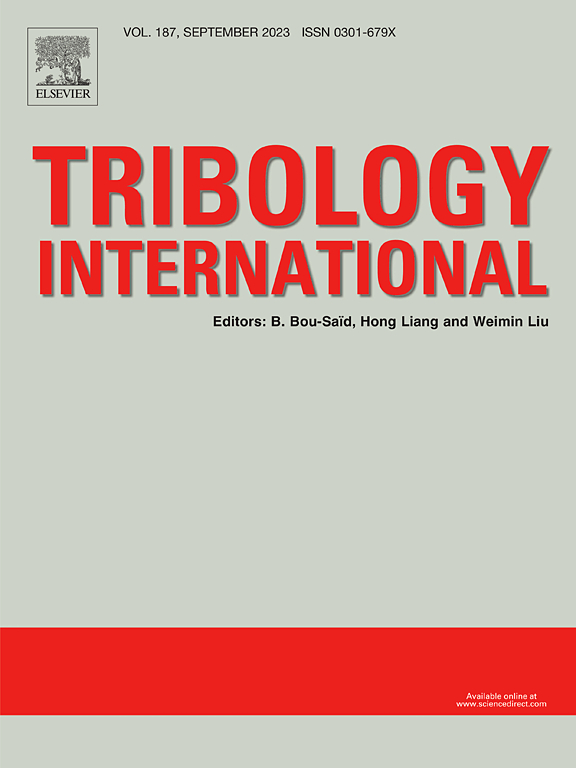最小水量润滑条件下β-碳化硅在化学机械抛光中的化学吸收及相互作用机理
IF 6.1
1区 工程技术
Q1 ENGINEERING, MECHANICAL
引用次数: 0
摘要
碳化硅(SiC)的化学机械抛光(CMP)由于其高硬度、化学惰性以及在抛光过程中容易产生表面和亚表面损伤而面临重大挑战。这些问题在最小量水润滑(MQWL)下变得更加严重,在这种情况下,保持材料去除效率和表面质量变得更加困难。本研究采用分子动力学模拟研究了超薄水膜润滑下β-SiC的CMP过程,重点研究了不同沟槽深度和沟槽宽度对材料去除率(MRR)、表面粗糙度、温度分布和残余应力的影响。结果表明,增加沟槽深度和宽度虽然可以降低MRR,但可以显著抑制残余应力和抛光引起的温升,从而提高表面完整性。定量地说,与干抛光相比,超薄水层的存在使最高温度降低了~ 30 %,残余von Mises应力降低了~ 20 %,同时获得了更光滑的表面(全球均方根- RMSg提高了~ 10-15 %),特别是在槽深8-16 Å和宽度0-4 Å处。此外,水分子在机械应力下解离成- oh、- h和- o -基团,- oh在SiC衬底和磨粒之间形成了强的化学吸附桥。这种相互作用促进化学键断裂,并导致比在非润滑环境中观察到的更高的MRR。这些发现不仅证明了MQWL在CMP过程中减少热损伤和机械损伤的有效性,而且为超薄水润滑下的化学力学协同机制提供了新的原子尺度的理解。在这里获得的见解可以指导优化表面图案和润滑策略的先进半导体CMP应用。本文章由计算机程序翻译,如有差异,请以英文原文为准。
Chemical absorption and interaction mechanisms of β-silicon carbide in chemical mechanical polishing under minimum water quantity lubrication
Chemical Mechanical Polishing (CMP) of silicon carbide (SiC) presents significant challenges due to its high hardness, chemical inertness, and tendency to generate surface and subsurface damage during polishing. These issues are exacerbated under minimum quantity water lubrication (MQWL), where maintaining material removal efficiency and surface quality becomes even more difficult. In this study, molecular dynamics simulations were employed to investigate the CMP process of β-SiC under ultrathin water film lubrication, focusing on the impact of different groove depths and groove widths on material removal rate (MRR), surface roughness, temperature distribution, and residual stress. The results reveal that although increasing groove depth and width reduces MRR, it significantly helps to suppress residual stress and polishing-induced temperature rise, which enhances surface integrity. Quantitatively, the presence of an ultrathin water layer reduced maximum temperature by up to ∼30 % and residual von Mises stress by ∼20 % compared to dry polishing, while achieving smoother surfaces (Root Mean Square global - RMSg improved by ∼10–15 %) especially at groove depths of 8–16 Å and widths of 0–4 Å. Additionally, the water molecules dissociate under mechanical stress into –OH, –H, and –O– groups, with –OH forming strong chemisorption bridges between the SiC substrate and abrasive particles. This interaction promotes chemical bond breaking and contributes to a higher MRR than that observed in non-lubricated environments. These findings not only demonstrate the effectiveness of MQWL in reducing thermal and mechanical damage during CMP but also provide a novel atomic-scale understanding of the chemomechanical synergistic mechanisms under ultrathin water lubrication. The insights gained here may guide the optimization of surface patterning and lubrication strategies for advanced semiconductor CMP applications.
求助全文
通过发布文献求助,成功后即可免费获取论文全文。
去求助
来源期刊

Tribology International
工程技术-工程:机械
CiteScore
10.10
自引率
16.10%
发文量
627
审稿时长
35 days
期刊介绍:
Tribology is the science of rubbing surfaces and contributes to every facet of our everyday life, from live cell friction to engine lubrication and seismology. As such tribology is truly multidisciplinary and this extraordinary breadth of scientific interest is reflected in the scope of Tribology International.
Tribology International seeks to publish original research papers of the highest scientific quality to provide an archival resource for scientists from all backgrounds. Written contributions are invited reporting experimental and modelling studies both in established areas of tribology and emerging fields. Scientific topics include the physics or chemistry of tribo-surfaces, bio-tribology, surface engineering and materials, contact mechanics, nano-tribology, lubricants and hydrodynamic lubrication.
 求助内容:
求助内容: 应助结果提醒方式:
应助结果提醒方式:


